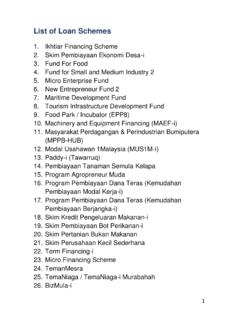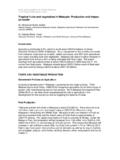Transcription of GUIDELINE FOR NEW SME DEFINITION - SME Corp
1 GUIDELINE FOR NEW SME DEFINITION Issued by: SME Corp. Malaysia Secretariat to the National SME Development Council October 2013 Updated: August 2016 1 1. Background Since 2005, a common DEFINITION for SMEs endorsed by the National SME Development Council (NSDC)1 has been adopted across Ministries and agencies, financial institutions and regulators involved in SME development programmes.
2 The DEFINITION is as follows: Manufacturing (including agro-based) and Manufacturing-related Services: Sales turnover of less than RM25 million OR full-time employees of less than 150 Primary Agriculture and Services (including ICT): Sales turnover of less than RM5 million OR full-time employees of less than 50 2. New SME DEFINITION Given that there have been many developments in the economy since 2005 such as price inflation, structural changes and change in business trends, a review of the DEFINITION was undertaken in 2013 and a new SME DEFINITION was endorsed at the 14th NSDC Meeting in July 2013.
3 The DEFINITION was simplified as follows: A business can qualify as an SME if it meets either one of the two specified criteria, namely sales turnover or full-time employees, whichever is lower. Details of the new DEFINITION are as follows: DEFINITION by Size of Operation Microenterprises across all sectors: Sales turnover of less than RM300,000 OR less than 5 full-time employees. Table 1 on page 2 summarises the DEFINITION for the small and medium categories for the respective sectors. 1 NSDC which serves as the highest authority to chart the national policy on SME development is chaired by YAB Prime Minister with members from 16 Ministries and key agencies.
4 Manufacturing: Sales turnover not exceeding RM50 million OR full-time employees not exceeding 200 workers Services and other sectors: Sales turnover not exceeding RM20 million OR full-time employees not exceeding 75 workers 2 Table 1: DEFINITION by Size of Operation Category Small Medium Manufacturing Sales turnover from RM300,000 to less than RM15 million OR full-time employees from 5 to less than 75 Sales turnover from RM15 million to not exceeding RM50 million OR full-time employees from 75 to not exceeding 200 Services & Other Sectors Sales turnover from RM300.
5 000 to less than RM3 million OR full-time employees from 5 to less than 30 Sales turnover from RM3 million to not exceeding RM20 million OR full-time employees from 30 to not exceeding 75 If a business fulfills either one criteria across the different sizes of operation, then the smaller size will be applicable. For example if a firm s sales turnover falls under microenterprise but employment falls under small, the business will be deemed as a microenterprise. Classification of Sectors Manufacturing refers to physical or chemical transformation of materials or components into new products.
6 Services refer to all services including distributive trade; hotels and restaurants; business, professional and ICT services; private education and health; entertainment; financial intermediation; and manufacturing-related services such as research and development (R&D), logistics, warehouse, engineering etc. Others refer to the remaining 3 key economic activities, namely: (i) Primary Agriculture Perennial crops ( rubber, oil palm , cocoa, pepper etc.) and cash crops ( vegetables, fruits etc.)
7 Livestock Forestry & logging Marine fishing Aquaculture (ii) Construction Infrastructure Residential & non-residential Special trade (iii) Mining & quarrying 3 Classification of economic activities for purposes of DEFINITION will be based on the malaysian Standard Industrial Classification (MSIC) 2008 codes as per Annex 1. This is to ensure comparability of data from various sources and to facilitate data harmonisation across the various providers of SME statistics. However, the list of activities is not exhaustive and may be subject to amendments from time to time.
8 Details of Qualifying Criteria Sales turnover refers to total revenue including other incomes. Full-time employees include all paid workers working for at least 6 hours a day and 20 days a month; or at least 120 hours a month. Full-time workers also include foreign and contract workers. However, the DEFINITION excludes working proprietors, active business partners and unpaid family members or friends who are working in the business and do not receive regular wages. OR basis means that a business will need to satisfy either one of the two criteria used in the DEFINITION (whichever is lower).
9 If a business exceeds the threshold set under both criteria for 2 consecutive years (based on its financial year/ accounting period) then it can no longer be deemed as SMEs. Similarly, a business that is previously large can become an SME if it fulfills the qualifying criteria of SMEs for 2 consecutive years. For statistical purposes, all business establishments including foreign businesses that fulfill the SME DEFINITION will be classified as SMEs. 3. Scope of SMEs In addition to the qualifying criteria sales turnover and full-time employees, there are additional conditions that must be fulfilled to be classified as SMEs: Types of Establishment SMEs refer to only pure business entities registered with the following bodies: (i) Companies Commission of Malaysia (SSM) either under the Registration of Business Act (1956) or Registration of Company Act (1965) or Limited Liability Partnerships (LLP) Act 2012.
10 Or (ii) Respective authorities or district offices in Sabah and Sarawak; or (iii) Respective statutory bodies for professional service providers. Shareholding Structure (i) Companies that are public-listed but are in the secondary bourses such as the ACE market, Malaysia Online Trading Platform for Unlisted 4 Market (MyULM) or in secondary markets / SME exchanges / unlisted markets in other countries will still be considered as SMEs for as long as they fulfil the qualifying criteria. (ii) Subsidiaries of firms in (i) will also be considered as SMEs for as long as they fulfill the qualifying criteria.







